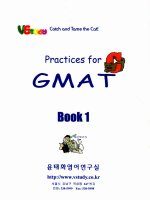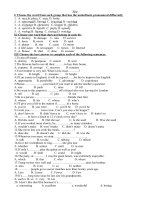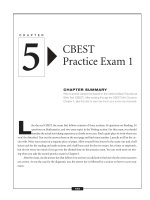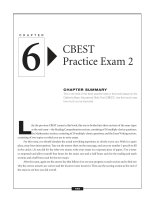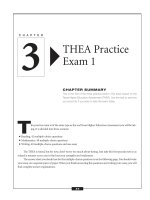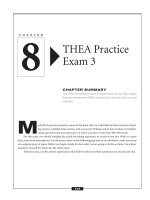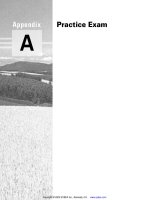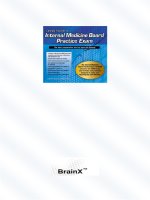THEA Practice Exam 3
Bạn đang xem bản rút gọn của tài liệu. Xem và tải ngay bản đầy đủ của tài liệu tại đây (260.45 KB, 42 trang )
M
uch like the previous practice exams in this book, this one is divided into three sections: a Read-
ing section, a Mathematics section, and a two-part Writing section that consists of multiple-
choice questions and one essay topic on which you are to write from 300–600 words.
For this exam, you should simulate the actual test-taking experience as closely as you can. Work in a quiet
place, away from interruptions. Use the answer sheet on the following page and, as you did before, write your essay
on a separate piece of paper. Before you begin, decide in what order you are going to do the sections. Use a timer
and allow yourself five hours for the entire exam.
After the exam, use the answer explanations that follow to find out which questions you missed and why.
CHAPTER
THEA Practice
Exam 3
CHAPTER SUMMARY
This is the third practice test in this book based on the Texas Higher
Education Assessment (THEA). Use this test to see how much you have
improved.
8
239
–
LEARNINGEXPRESS ANSWER SHEET
–
241
Answer Sheet
SECTION 1: READING SECTION 2: MATH SECTION 3: WRITING PART A
1. abcd
2. abcd
3. abcd
4. abcd
5. abcd
6. abcd
7. abcd
8. abcd
9. abcd
10. abcd
11. abcd
12. abcd
13. abcd
14. abcd
15. abcd
16. abcd
17. abcd
18. abcd
19. abcd
20. abcd
21. abcd
22. abcd
23. abcd
24. abcd
25. abcd
26. abcd
27. abcd
28. abcd
29. abcd
30. abcd
31. abcd
32. abcd
33. abcd
34. abcd
35. abcd
36. abcd
37. abcd
38. abcd
39. abcd
40. abcd
41. abcd
42. abcd
1. abcd
2. abcd
3. abcd
4. abcd
5. abcd
6. abcd
7. abcd
8. abcd
9. abcd
10. abcd
11. abcd
12. abcd
13. abcd
14. abcd
15. abcd
16. abcd
17. abcd
18. abcd
19. abcd
20. abcd
21. abcd
22. abcd
23. abcd
24. abcd
25. abcd
26. abcd
27. abcd
28. abcd
29. abcd
30. abcd
31. abcd
32. abcd
33. abcd
34. abcd
35. abcd
36. abcd
37. abcd
38. abcd
39. abcd
40. abcd
41. abcd
42. abcd
43. abcd
44. abcd
45. abcd
46. abcd
47. abcd
48. abcd
1. abcd
2. abcd
3. abcd
4. abcd
5. abcd
6. abcd
7. abcd
8. abcd
9. abcd
10. abcd
11. abcd
12. abcd
13. abcd
14. abcd
15. abcd
16. abcd
17. abcd
18. abcd
19. abcd
20. abcd
21. abcd
22. abcd
23. abcd
24. abcd
25. abcd
26. abcd
27. abcd
28. abcd
29. abcd
30. abcd
31. abcd
32. abcd
33. abcd
34. abcd
35. abcd
36. abcd
37. abcd
38. abcd
39. abcd
40. abcd
Section 1: Reading
Questions 1–6 are based on the following passage.
(1) The late 1980s found the landscape of popular
music in America dominated by a distinctive style of
rock and roll known as Glam Rock or Hair Metal—so
called because of the over-styled hair, makeup, and
wardrobe worn by the genre’s ostentatious rockers.
Bands like Poison, White Snake, and Mötley Crüe
popularized glam rock with their power ballads and
flashy style, but the product had worn thin by the
early 1990s. The mainstream public, tired of an act
they perceived as symbolic of the superficial 1980s,
was ready for something with a bit of substance.
(2) In 1991, a Seattle-based band named Nir-
vana shocked the corporate music industry with the
release of its debut single “Smells Like Teen Spirit,”
which quickly became a huge hit all over the world.
Nirvana’s distorted, guitar-laden sound and
thought-provoking lyrics were the antithesis of glam
rock, and the youth of America were quick to pledge
their allegiance to the brand new movement known
as grunge.
(3) Grunge actually got its start in the Pacific
Northwest during the mid 1980s, the offspring of the
metal-guitar driven rock of the 1970s and the hard-
core, punk music of the early 1980s. Nirvana had
simply brought into the mainstream a sound and
culture that got its start years before with bands like
Mudhoney, Soundgarden, and Green River. Grunge
rockers derived their fashion sense from the youth
culture of the Pacific Northwest: a melding of punk
rock style and outdoors clothing like flannels, heavy
boots, worn-out jeans, and corduroys. At the height
of the movement’s popularity, when other Seattle
bands like Pearl Jam and Alice in Chains were all the
rage, the trappings of grunge were working their
way to the height of American fashion. Like the
music, teenagers were fast to embrace the grunge
fashion because it represented defiance against cor-
porate America and shallow pop culture.
(4) Many assume that grunge got its name
from the unkempt appearance of its musicians and
their dirty, often distorted guitar sounds. However,
rock writers and critics have used the word “grunge”
since the 1970s. While no one can say for sure who
was the first to characterize a Seattle band as
“grunge,” the most popular theory is that it origi-
nated with the lead singer of Mudhoney, Mark Arm.
In a practical joke against a local music magazine, he
placed advertisements all over Seattle for a band
that did not exist. He then wrote a letter to the mag-
azine complaining about the quality of the fake
band’s music. The magazine published his critique,
one part of which stated, “I hate Mr. Epp and the
Calculations! Pure grunge!”
(5) The popularity of grunge music was
ephemeral; by the mid- to late-1990s its influence
upon American culture had all but disappeared, and
most of its recognizable bands were nowhere to be
seen on the charts. The heavy sound and themes of
grunge were replaced on the radio waves by bands
like NSYNC, the Backstreet Boys, and the bub-
blegum pop of Britney Spears and Christina
Aguilera.
(6) There are many reasons why the Seattle
sound faded out of the mainstream as quickly as it
rocketed to prominence, but the most glaring reason
lies at the defiant, anti-establishment heart of the
grunge movement itself. It is very hard to buck the
trend when you are the one setting it, and many of
the grunge bands were never comfortable with the
celebrity that was thrust upon them. One of the
most successful Seattle groups of the 1990s, Pearl
Jam, filmed only one music video, and refused to
play large venues. Ultimately, the simple fact that
many grunge bands were so against mainstream
rock stardom eventually took the movement back to
where it started: underground. The American main-
stream public, as quick as they were to hop onto the
grunge bandwagon, were just as quick to hop off,
and move onto something else.
–
THEA PRACTICE EXAM 3
–
243
1. The author’s description of glam rockers in para-
graph 1 indicates that they
a. cared more about the quality of their music
than money.
b. were mainly style over substance.
c. were unassuming and humble.
d. were songwriters first, and performers second.
2. The word ostentatious in paragraph 1 most
nearly means
a. stubborn.
b. youthful.
c. showy.
d. unadorned.
3. In paragraph 3 the phrase the trappings of grunge
refers to
a. the distorted sound of grunge music.
b. what the grunge movement symbolized.
c. the unattractiveness of grunge fashion.
d. the clothing typical of the grunge movement.
4. Which of the following is not associated with the
grunge movement?
a. Mr. Epp and the Calculations
b. Pearl Jam
c. Nirvana
d. White Snake
5. Which of the following words best describes the
relationship between grunge music and its main-
stream popularity?
a. solid
b. contrary
c. enduring
d. acquiescent
6. In paragraph 5, the world ephemeral most nearly
means
a. enduring.
b. unbelievable.
c. a fluke.
d. fleeting.
Questions 7–13 are based on the following passage.
(1) Without a doubt, one of the most interesting
mythological characters is the Greek god Pro-
metheus. A complex character with an undying
love for the human beings he created, Prometheus
embodies a rich combination of often contradictory
characteristics, including loyalty and defiance, trick-
ery and trustworthiness. He shows resilience and
resolve in his actions yet weakness in his fondness
for humankind.
(2) To reward Prometheus (whose name
means “forethought” ) and his brother Epimetheus
(“afterthought”) for helping him defeat the Titans,
Zeus, the great ruler of Olympian gods, gave the
brothers the task of creating mortals to populate the
land around Mount Olympus. Prometheus asked
Epimetheus to give the creatures their various char-
acteristics, such as cunning, swiftness, and flight. By
the time he got to man, however, there was nothing
left to give. So Prometheus decided to make man in
his image: he stood man upright like the gods and
became the benefactor and protector of mankind.
(3) Though Prometheus was particularly fond
of his creation, Zeus didn’t care for mankind and
didn’t want men to have the divine gift of knowl-
edge. But Prometheus took pity on mortal men and
gave them knowledge of the arts and sciences,
including the healing arts and agriculture.
(4) Always seeking the best for his creation, one
day Prometheus conspired to trick Zeus to give the
best meat of an ox to men instead of Zeus. He cut up
–
THEA PRACTICE EXAM 3
–
244
the ox and hid the bones in layers of fat; then he hid
the meat and innards inside the hide. When
Prometheus presented the piles to Zeus, Zeus chose
the pile that looked like fat and meat. He was
enraged to find that it was nothing but bones.
(5) To punish Prometheus for his deceit and
his fondness for humans, Zeus forbade men fire—a
symbol of creative power, life force, and divine
knowledge. But Prometheus would not let his chil-
dren be denied this greatest of gifts. He took a hol-
low reed, stole fire from Mount Olympus, and gave
it to men. With this divine power, creativity, inge-
nuity, and culture flourished in the land of mortals.
(6) Again, Zeus punished man for Prome-
theus’s transgression, this time by sending the first
woman, Pandora, to Earth. Pandora brought with
her a “gift” from Zeus: a jar filled with evils of every
kind. Prometheus knew Zeus to be vengeful and
warned Epimetheus not to accept any gifts from
Zeus, but Epimetheus was too taken with Pan-
dora’s beauty and allowed her to stay. Eventually
Pandora opened the jar she’d been forbidden to
open, releasing all manner of evils, including
Treachery, Sorrow, Villainy, Misfortune, and
Plague. At the bottom of the jar was Hope, but
Pandora closed the lid before Hope could escape.
(7) Prometheus drew Zeus’s greatest wrath
when he refused to tell Zeus which of Zeus’s sons
would kill him and take over the throne. Believing he
could torture Prometheus into revealing the secret,
Zeus bound his flesh and ate his liver, which would
regenerate each night. But Prometheus refused to
reveal his knowledge of the future to Zeus and main-
tained his silence. Eventually, Prometheus was
released by Heracles (also known as Hercules), the
last mortal son of Zeus and the strongest of the
mortals. Soon afterwards, Prometheus received
immortality from a dying centaur, to take his place
forever among the great gods of Olympus.
7. The main idea of the first paragraph is that
Prometheus
a. is disrespectful of authority.
b. is the mythological creator of humans.
c. has many admirable characteristics.
d. is a fascinating character because of his
complexity.
8. The author’s primary purpose in this passage
is to
a. demonstrate the vengeful nature of Zeus.
b. show how much Prometheus cared for
humans.
c. create in readers an interest in mythology.
d. relate the story of Prometheus.
9. Based on this passage, it can be inferred that
Zeus disliked humans because
a. Prometheus spent too much time with them.
b. Prometheus cared for humans more than he
did for Zeus.
c. humans could not be trusted.
d. humans did not respect Zeus.
10. Zeus becomes angry at Prometheus for all of the
following EXCEPT
a. creating man.
b. giving man fire.
c. being excessively fond of humans.
d. refusing to reveal which of his sons would kill
him.
–
THEA PRACTICE EXAM 3
–
245
11. Based on this passage, the relationship between
Prometheus and humans can best be described as
that of
a. parent and child.
b. close friends.
c. master and servants.
d. reluctant allies.
12. The word transgression as used in the first sen-
tence of paragraph 6 means
a. villainy.
b. trespass.
c. irregularity.
d. disobedience.
13. The content and style of this passage suggests
that the intended audience
a. are experts on Greek mythology.
b. are religious officials.
c. is a general lay audience.
d. is a scholarly review board.
Questions 14–19 are based on the following passage.
(1) A series of studies to determine whether victims
of violence and neglect later become criminals or
violent offenders themselves examined the lives of
child victims identified in court cases dating from
1967 to 1971. The goal of the studies was to provide
data that would enable early identification and care-
ful handling of cases to avoid an early criminal jus-
tice path.
(2) The initial study, conducted in a midwest-
ern county, was based on documented records of
1,575 court cases of physical abuse, sexual abuse,
and neglect. At the time the cases came to court, all
of the children were under age eleven, and the
mean age was about six. To isolate the effects of
abuse and neglect from those of other variables
such as gender, race, and poverty, researchers cre-
ated a control group whose members matched the
sample group on the basis of age, gender, race, and
family social class.
(3) During the study’s initial phase in 1988,
researchers examined the criminal records of sam-
ple and control group members and compiled his-
tories for all nontraffic offenses at the local, state,
and federal levels. In 1994 researchers examined
the arrest records again and found that, in the late
1980s, 28% of the sample group had been
arrested—11% for violent crime. Of the control
group, 21% had been arrested—8% for violent
crime. Researchers noted that the differences in
arrest rates began to emerge early, at the ages of 8
and 9. At this time, however, only 65% of the vic-
tims had passed through the peak years of violent
offending (20–25).
(4) By 1994 almost half of the sample group
had been arrested for some type of nontraffic
offense. Eighteen percent had been arrested for vio-
lent crime—an increase of 4% in the six years since
arrest records were first checked. Rates of arrest were
at least 25% higher among African-American vic-
tims. Both males and females reported having made
suicide attempts.
(5) Another key finding was that the rates of
arrest for children who were victims of neglect
(defined as an excessive failure by caregivers to pro-
vide food, shelter, clothing, and medical attention)
were almost as high as the rate for physically abused
children.
(6) In 1994, nearly 100% of the sample were 26
or older. After recompiling criminal histories, larger
differences between the sample and control groups
were found. 49% of the sample group had been
arrested, 18% for violent crime; whereas only 38%
of the control group had been arrested, 14% for
violent crime.
(7) Preliminary findings indicate a need for
criminal justice and social service agencies to take a
proactive, preventive stance to stop the cycle of
violence.
–
THEA PRACTICE EXAM 3
–
246
14. Which of the following is the most accurate defi-
nition of the term control group (in the second
paragraph)?
a. a group of subjects selected to make sure the
results of an experiment are not caused by a
factor other than the one being studied
b. a group of scientists selected to watch the
experimenter to make sure there are no seri-
ous mistakes in method
c. a group of objective lay observers selected to
make sure the experiment is not biased
d. a group of subjects who do not know the
object of the experiment
15. How did the number of arrests of physically
abused youth relate to that of neglected youth?
a. They were 25% lower.
b. They were slightly lower.
c. They were nearly the same.
d. They were 25% higher.
16. What was the percentage of violent crime arrests
in the control group after the first phase of the
study?
a. 4%
b. 8%
c. 11%
d. 21%
17. In the late 1980s, what did researchers discover
about the two study groups?
a. The disparity of arrests materialized at young
ages.
b. Less than half of the sample group was beyond
the age of 25.
c. The average age of the participants was 11.
d. The control group committed more violent
crime than the sample group.
18. One reason for the difference in violent crime
rates between the 1988 and 1994 phases of the
study was that
a. victims were closer to the age of peak violent
activity in 1988.
b. most victims who were prone to violence had
already committed crimes in 1988.
c. more victims evinced emotional problems by
attempting suicide in 1994.
d. more victims had passed through the age of
peak violent activity in 1994.
19. One objective of the studies was to
a. recommend greater participation by social
service agencies.
b. analyze statistics for traffic violations.
c. generate information about an individual’s
potential crime pattern.
d. separate physical abuse from sexual abuse.
Questions 20–24 are based on the following passage.
(1) For perhaps the tenth time since the clock struck
two, Sylvia crosses to the front-facing window of
her apartment, pulls back the blue curtain and looks
down at the street. People hurry along the sidewalk;
however, although she watches for several long
moments, she sees no one enter her building.
(2) She walks back to the center of the high-
ceilinged living room, where she stands frowning
and twisting a silver bracelet around and around
on her wrist. She is an attractive young woman,
although perhaps too thin and with a look that is
faintly ascetic; her face is narrow and delicate, her
fine, light-brown hair caught back by a tortoiseshell
comb. She is restless now, because she is being kept
waiting. It is nearly two-thirty—a woman named
Lola Parrish was to come at two o’clock to look at the
apartment.
–
THEA PRACTICE EXAM 3
–
247
(3) She considers leaving a note and going out.
The woman is late, after all, and besides, Sylvia is cer-
tain that Lola Parrish will not be a suitable person
with whom to share the apartment. On the phone
she had sounded too old, for one thing, her voice
oddly flat and as deep as a man’s. However, the
moment for saying the apartment was no longer
available slipped past, and Sylvia found herself agree-
ing to the two o’clock appointment. If she leaves
now, as she has a perfect right to do, she can avoid
the awkwardness of turning the woman away.
(4) Looking past the blue curtain, however,
she sees the sky is not clear but veiled by a white haze,
and the air is oppressively still. She knows that the
haze and the stillness and heat are conditions that
often precede a summer thunderstorm, one of the
abrupt, swiftly descending electrical storms that have
terrified her since she was a child. If a storm comes,
she wants to be at home in her own place.
(5) She walks back to the center of the room,
aware now that the idea of sharing the apartment,
never appealing, born of necessity, has actually
begun to repel her. Still, she knows she will have to
become accustomed to the notion, because her sav-
ings are nearly gone and the small trust fund left her
by her father is exhausted. She has a job, but it does
not pay well, and, although she has considered seek-
ing another (perhaps something connected with
music—in her childhood she had played the flute
and people had said she was gifted), lately she has
found herself dragged down by a strange inertia.
(6) Besides, although her job pays poorly, it
suits her. She is a typist in a natural history museum,
in an office on the top floor, near the aviary. The man
for whom she works, one of the curators, is rarely in,
so Sylvia has the office to herself. The aviary consists
of three enormous rooms, painted white, each with
a high vaulted ceiling. The birds themselves, so beau-
tifully mounted they seem alive, are displayed in
elaborate dioramas. Behind glass, they perch in trees
with leaves of sculpted metal, appearing to soar
through painted forests, above painted rivers and
marshes. Everything is rendered in exquisite detail.
And in her office there is a skylight. The location of
the office, so near the open sky, suits her, too,
because she is mildly claustrophobic.
20. Which of the following adjectives best describes
Sylvia’s mood as depicted in the story?
a. anxious
b. angry
c. meditative
d. serene
21. Based on the tone of the passage and the descrip-
tion of Sylvia at this moment, which of the fol-
lowing is the most likely reason Sylvia’s job “suits
her?”
a. Her office is tastefully decorated.
b. She is fond of her employer, the museum
curator.
c. She is musical and enjoys the singing of birds.
d. She is able to work alone in a space that feels
open.
22. When Sylvia looks out her window, the weather
appears
a. gloomy.
b. ominous.
c. springlike.
d. bracing.
23. Based on the story, which of the following would
most likely describe Sylvia’s behavior in relation-
ship to other people?
a. distant
b. overbearing
c. dependent
d. malicious
–
THEA PRACTICE EXAM 3
–
248
24. Which of the following is most likely the author’s
purpose in describing in detail the museum
where Sylvia works?
a. Everything in it, though beautiful and tasteful,
seems frozen or removed from life and reflects
some aspect of Sylvia’s character.
b. The fact that it is light and airy and filled with
beautiful dioramas reflects Sylvia’s youth and
her wish for something better.
c. Some part of the story, perhaps a love affair
between Sylvia and her boss, will probably
take place there.
d. The killing and mounting of the beautiful
birds will probably play an important part in
the story.
Questions 25–31 are based on the following passage.
(1) The poet in Samuel Taylor Coleridge’s “Kubla
Khan” wakes from a dream or vision and announces
that if people knew what he had seen they would
shun him and cry out a warning:
Beware, Beware!
His flashing eyes, his floating hair
Weave a circle round him thrice
And close your eyes in holy dread,
For he on honey-dew hath fed,
And drunk the milk of Paradise.
Similarly, in his famous study of myth, The Hero
With a Thousand Faces, Joseph Campbell writes
about the archetypal hero who has ventured outside
the boundaries of the village and, after many trials
and adventures, has returned with the boon that
will save or enlighten his fellows. Like Carl Jung,
Campbell believes that the story of the hero is part
of the collective unconscious of all humankind. He
likens the returning hero to the sacred or tabooed
personage described by James Frazier in The Golden
Bough. Such an individual must, in many instances
of myth, be insulated from the rest of society, “not
merely for his own sake but for the sake of others; for
since the virtue of holiness is, so to say, a powerful
explosive which the smallest touch can detonate, it
is necessary in the interest of the general safety to
keep it within narrow bounds.”
(2) Like Coleridge’s poet, the returning hero of
myth has been to a place of wonder and holiness.
And, Campbell maintains, the hero, “to complete his
adventure, must survive the impact of the world.” He
or she must return to the daylight world of ordinary
human society, where he is apt to be regarded
________ as the object both of wonder and dread.
As Coleridge’s poem illustrates, the same fate can
also befall the poet who has journeyed into the realm
of imagination.
(3) There is ________ between the archetypal
hero who has journeyed into the wilderness and the
poet who has journeyed into the realm of imagina-
tion. Both places are dangerous and full of won-
ders, and both, at their deepest levels, are taken
inward. They are journeys that take place into the
kingdom of the mind. “The poets and philosophers
before me discovered the unconscious,” Sigmund
Freud has said. It is into the unconscious that the
poet and the hero of myth both venture. That world,
writes Campbell, the “human kingdom, beneath
the floor of the comparatively neat little dwelling
that we call our consciousness, goes down into
unsuspected Aladdin caves. There not only jewels
but dangerous jinn abide....”
25. Which of the following words would fit best into
the blank in paragraph 2?
a. suspiciously
b. reluctantly
c. unfairly
d. ambivalently
–
THEA PRACTICE EXAM 3
–
249
26. Based on the passage, which of the following
would best describe the hero’s journey?
a. wonderful
b. terrifying
c. awesome
d. whimsical
27. The title of Campbell’s book, The Hero With a
Thousand Faces, is meant to convey
a. the many villagers whose lives are changed by
the story the hero has to tell.
b. the fact that the hero journeys into many dif-
ferent imaginary countries.
c. the universality of the myth of the hero who
journeys into the wilderness.
d. the many languages into which the myth of
the hero has been translated.
28. Based on the passage, which of the following best
describes the story that will likely be told by
Campbell’s returning hero and Frazier’s sacred or
tabooed personage?
a. a radically mind-altering story
b. a story that will terrify people to no good end
c. a warning of catastrophe to come
d. a story based on a dangerous lie
29. Which of the following is the most accurate defi-
nition of boon as the word is used in the first
paragraph?
a. gift
b. blessing
c. charm
d. prize
30. The phrase that would most accurately fit into
the blank in the first sentence of the third para-
graph is
a. much similarity.
b. a wide gulf.
c. long-standing conflict.
d. an abiding devotion.
31. As mentioned at the end of the passage,
“Aladdin’s caves” are most likely to be found in
a. the mountains.
b. fairy tales.
c. the fantasies of the hero.
d. the unconscious mind.
Questions 32–36 are based on the following passage.
(1) Firefighters know that the dangers of motor-
vehicle fires are too often overlooked. In the United
States, one out of five fires involves motor vehicles,
resulting each year in 600 deaths, 2,600 civilian
injuries, and 1,200 injuries to firefighters. The rea-
son for so many injuries and fatalities is that a vehi-
cle can generate heat of up to 1,500° F. (The boiling
point of water is 212° F and the cooking temperature
for most foods is 350° F.)
(2) Because of the intense heat generated in a
vehicle fire, parts of the car or truck may burst, caus-
ing debris to shoot great distances and turning
bumpers, tire rims, drive shafts, axles, and even
engine parts into lethal shrapnel. Gas tanks may
rupture and spray highly flammable fuel. In addi-
tion, hazardous materials such as battery acid, even
without burning, can cause serious injury.
(3) Vehicle fires can also produce toxic gases.
Carbon monoxide, which is produced during a fire,
is an odorless and colorless gas but in high concen-
trations is deadly. Firefighters must wear self-
contained breathing devices and full protective
fire-resistant gear when attempting to extinguish a
vehicle fire.
32. The passage suggests that one reason firefighters
wear self-contained breathing devices is to pro-
tect themselves against
a. flying car parts.
b. intense heat.
c. flammable fuels.
d. carbon monoxide.
–
THEA PRACTICE EXAM 3
–
250
33. The passage suggests that most injuries in motor-
vehicle fires are caused by
a. battery acid.
b. odorless gases.
c. extremely high temperatures.
d. firefighters’ mistakes.
34. The main focus of this passage is on
a. how firefighters protect themselves.
b. the dangers of motor-vehicle fires.
c. the amount of heat generated in some fires.
d. the dangers of odorless gases.
35. The cooking temperature for food (350° F) is
most likely included in the passage mainly to
show the reader
a. at what point water boils.
b. how hot motor-vehicle fires really are.
c. why motor-vehicle fires produce toxic gases.
d. why one out of five fires involves a motor
vehicle.
36. One reason that firefighters must be aware of the
possibility of carbon monoxide in motor-vehicle
fires is that carbon monoxide
a. is highly concentrated.
b. cannot be protected against.
c. can shoot great distances into the air.
d. cannot be seen or smelled.
Questions 37–42 are based on the following passage.
(1) The composer Wolfgang Amadeus Mozart’s
remarkable musical talent was apparent even before
most children can sing a simple nursery rhyme.
Wolfgang’s older sister Maria Anna, who the family
called Nannerl, was learning the clavier, an early
keyboard instrument, when her three-year-old
brother took an interest in playing. As Nannerl later
recalled, Wolfgang “often spent much time at the
clavier, picking out thirds, which he was always
striking, and his pleasure showed that it sounded
good.” Their father Leopold, an assistant concert-
master at the Salzburg Court, recognized his chil-
dren’s unique gifts and soon devoted himself to their
musical education.
(2) Born in Salzburg, Austria, on January 27,
1756, Wolfgang was five when he learned his first
musical composition—in less than half an hour. He
quickly learned other pieces, and by age five com-
posed his first original work. Leopold settled on a
plan to take Nannerl and Wolfgang on tour to play
before the European courts. Their first venture was
to nearby Munich where the children played for
Maximillian III Joseph, elector of Bavaria. Leopold
soon set his sights on the capital of the Hapsburg
Empire, Vienna. On their way to Vienna, the family
stopped in Linz, where Wolfgang gave his first pub-
lic concert. By this time, Wolfgang was not only a
virtuoso harpsichord player but he had also mas-
tered the violin. The audience at Linz was stunned
by the six-year-old, and word of his genius soon
traveled to Vienna. In a much-anticipated concert,
the children appeared at the Schönbrunn Palace on
October 13, 1762. They utterly charmed the emperor
and empress.
(3) Following his success, Leopold was inun-
dated with invitations for the children to play, for a
fee. Leopold seized the opportunity and booked as
many concerts as possible at courts throughout
Europe. After the children performed at the major
court in a region, other nobles competed to have the
“miracle children of Salzburg” play a private concert
in their homes. A concert could last three hours,
and the children played at least two a day. Today,
Leopold might be considered the worst kind of stage
parent, but at the time it was not uncommon for
prodigies to make extensive concert tours. Even so,
it was an exhausting schedule for a child who was
just past the age of needing an afternoon nap.
(4) Wolfgang fell ill on tour, and when the
family returned to Salzburg on January 5, 1763,
–
THEA PRACTICE EXAM 3
–
251
Wolfgang spent his first week at home in bed with
acute rheumatoid arthritis. In June, Leopold
accepted an invitation for the children to play at
Versailles, the lavish palace built by Loius XIV, king
of France. Wolfgang did not see his home in
Salzburg for another three years. When they weren’t
performing, the Mozart children were likely to be
found bumping along the rutted roads in an
unheated carriage. Wolfgang passed the long
uncomfortable hours in the imaginary Kingdom of
Back, of which he was king. He became so engrossed
in the intricacies of his make-believe court that he
persuaded a family servant to make a map showing
all the cities, villages, and towns over which he
reigned.
(5) The king of Back was also busy composing.
Wolfgang completed his first symphony at age nine
and published his first sonatas that same year. Before
the family returned to Salzburg, Wolfgang had
played for, and amazed, the heads of the French and
British royal families. He had also been plagued with
numerous illnesses. Despite Wolfgang and Nannerl’s
arduous schedule and international renown, the
family’s finances were often strained. The pattern
established in his childhood would be the template
of the rest of his short life. Wolfgang Amadeus
Mozart toiled constantly, was lauded for his genius,
suffered from illness, and struggled financially, until
he died at age 35. The remarkable child prodigy
who more than fulfilled his potential was buried in
an unmarked grave, as was the custom at the time,
in Vienna suburb.
37. The primary purpose of the passage is to
a. illustrate the early career and formative expe-
riences of a musical prodigy.
b. describe the classical music scene in the eigh-
teenth century.
c. uncover the source of Wolfgang Amadeus
Mozart’s musical genius.
d. prove the importance of starting a musical
instrument an early age.
38. According to the passage, Wolfgang became
interested in music because
a. his father thought it would be profitable.
b. he had a natural talent.
c. he saw his sister learning to play.
d. he came from a musical family.
39. What was the consequence of Wolfgang’s first
public appearance?
a. He charmed the emperor and empress of
Hapsburg.
b. Leopold set his sights on Vienna.
c. Word of Wolfgang’s genius spread to the
capital.
d. He mastered the violin.
40. The author’s attitude toward Leopold Mozart can
best be characterized as
a. vehement condemnation.
b. mild disapproval.
c. glowing admiration.
d. incredulity.
41. In the second sentence of paragraph 4, the word
lavish most nearly means
a. wasteful.
b. clean.
c. extravagant.
d. beautiful.
42. The author uses the anecdote about Mozart’s
Kingdom of Back to illustrate
a. Mozart’s admiration for the composer Johann
Sebastian Bach.
b. the role imagination plays in musical
composition.
c. that Mozart was mentally unstable.
d. that Mozart’s only friends were imaginary
people and family servants.
–
THEA PRACTICE EXAM 3
–
252
Section 2: Mathematics
1. A salesman drives 2,052 miles in 6 days, stopping
at 2 towns each day. How many miles does he
average between stops?
a. 171
b. 342
c. 513
d. 684
2. A school cafeteria manager spends $540 on sil-
verware. If a place setting includes 1 knife, 1 fork,
and 2 spoons, how many place settings did the
manager buy?
a. 90
b. 108
c. 135
d. There is not enough information to solve this
problem.
Question 3 is based on the following diagram.
3. The pie chart above shows quarterly sales for
Cool-Air’s air-conditioning units. Which of the
following combinations contributed 70% to the
total?
a. 1st and 2nd quarters
b. 3rd and 4th quarters
c. 2nd and 3rd quarters
d. 2nd and 4th quarters
4. An office uses 2 dozen pencils and 3
ᎏ
1
2
ᎏ
reams of
paper each week. If pencils cost 5 cents each and
a ream of paper costs $7.50, how much does it
cost to supply the office for a week?
a. $7.55
b. $12.20
c. $26.25
d. $27.45
5. What is the estimated product when 157 and 817
are rounded to the nearest hundred and
multiplied?
a. 160,000
b. 180,000
c. 16,000
d. 80,000
6. Mr. James Rossen is just beginning a computer
consulting firm and has purchased the following
equipment:
3 telephone sets, each costing $125
2 computers, each costing $1,300
2 computer monitors, each costing $950
1 printer costing $600
1 answering machine costing $50
Mr. Rossen is reviewing his finances. What
should he write as the total value of the equip-
ment he has purchased so far?
a. $3,025
b. $3,275
c. $5,400
d. $5,525
7. Roger earned $24,355 this year, and $23,000 the
year before. To the nearest $100, what did Roger
earn in the past two years?
a. $47,300
b. $47,400
c. $47,455
d. $47,500
Sales for 2004
4th Qtr
16%
1st Qtr
13%
2nd Qtr
17%
3rd Qtr
54%
–
THEA PRACTICE EXAM 3
–
253
8. A cafeteria has three different options for lunch.
For $2, a customer can get either a sandwich or
two pieces of fruit.
For $3, a customer can get a sandwich and one
piece of fruit.
For $4, a customer can get either two sand-
wiches, or a sandwich and two pieces of fruit.
If Jan has $6 to pay for lunch for her and
her husband, which of the following is NOT a
possible combination?
a. three sandwiches and one piece of fruit
b. two sandwiches and two pieces of fruit
c. one sandwich and four pieces of fruit
d. three sandwiches and no fruit
9. Benito earns $12.50 for each hour that he works.
If Benito works 8.5 hours per day, five days a
week, without any overtime, how much does he
earn in a week?
a. $100.00
b. $106.25
c. $406.00
d. $531.25
Question 10 is based on the following diagram.
PRODUCTION OF TRACTORS FOR
THE MONTH OF APRIL
FACTORY APRIL OUTPUT
Dallas 450
Houston 425
Lubbock
Amarillo 345
TOTAL 1,780
10. What was Lubbock’s production in the month of
April?
a. 345
b. 415
c. 540
d. 560
11. Melissa can grade five of her students’ papers in
an hour. Joe can grade four of the same papers in
an hour. If Melissa works for three hours grad-
ing, and Joe works for two hours, what percent-
age of the 50 students’ papers will be graded?
a. 44%
b. 46%
c. 52%
d. 54%
12. Three students take a spelling test. Anthony takes
his test in 20 minutes. Alison finishes in 17 min-
utes, and Gracie finishes in just 14 minutes. What
is the average time for the three students?
a. 20 minutes
b. 19 minutes
c. 17 minutes
d. 14 minutes
13. A steel box has a base length of 12 inches and a
width of 5 inches. If the box is 10 inches tall,
what is the total volume of the box?
a. 580 cubic inches
b. 600 cubic inches
c. 640 cubic inches
d. 720 cubic inches
14. An average of 90% is needed on five tests to
receive an A in a class. If a student received scores
of 95, 85, 88, and 84 on the first four tests, what
score will the student need to achieve on the fifth
test to get an A?
a. 94
b. 96
c. 98
d. 99
–
THEA PRACTICE EXAM 3
–
254
